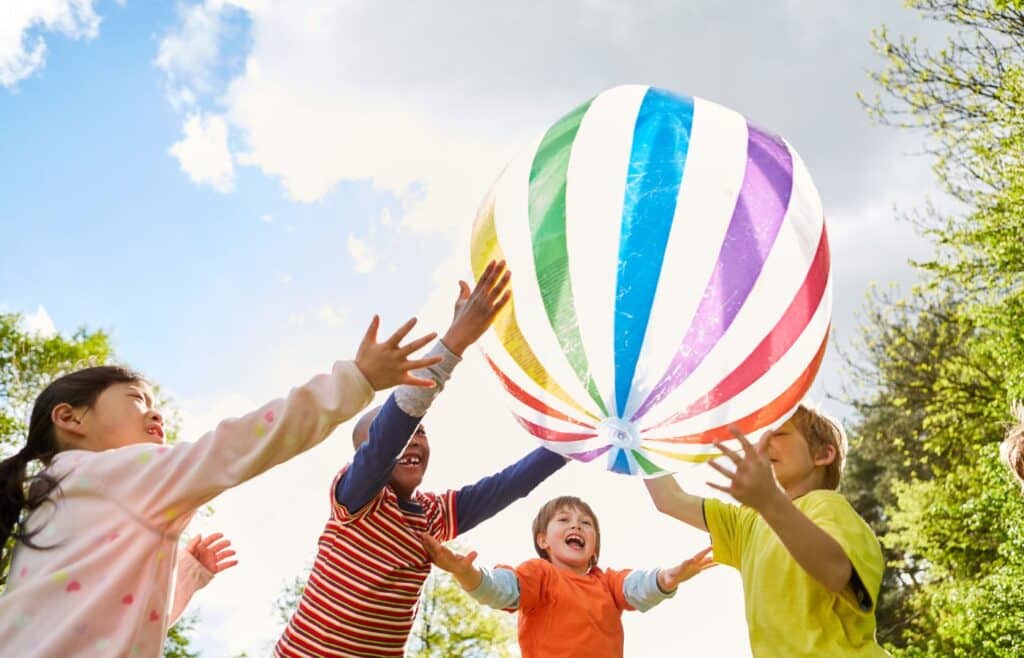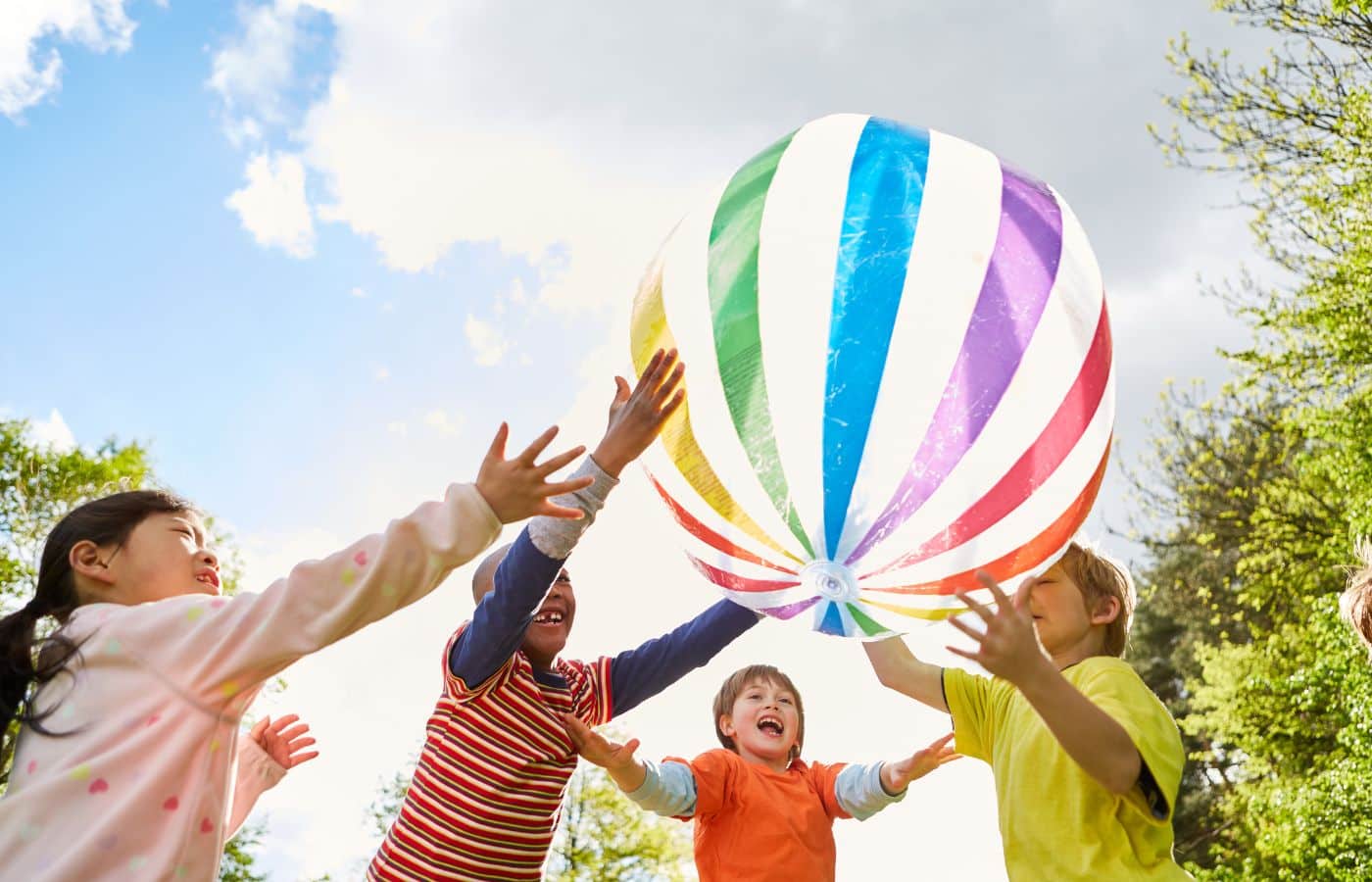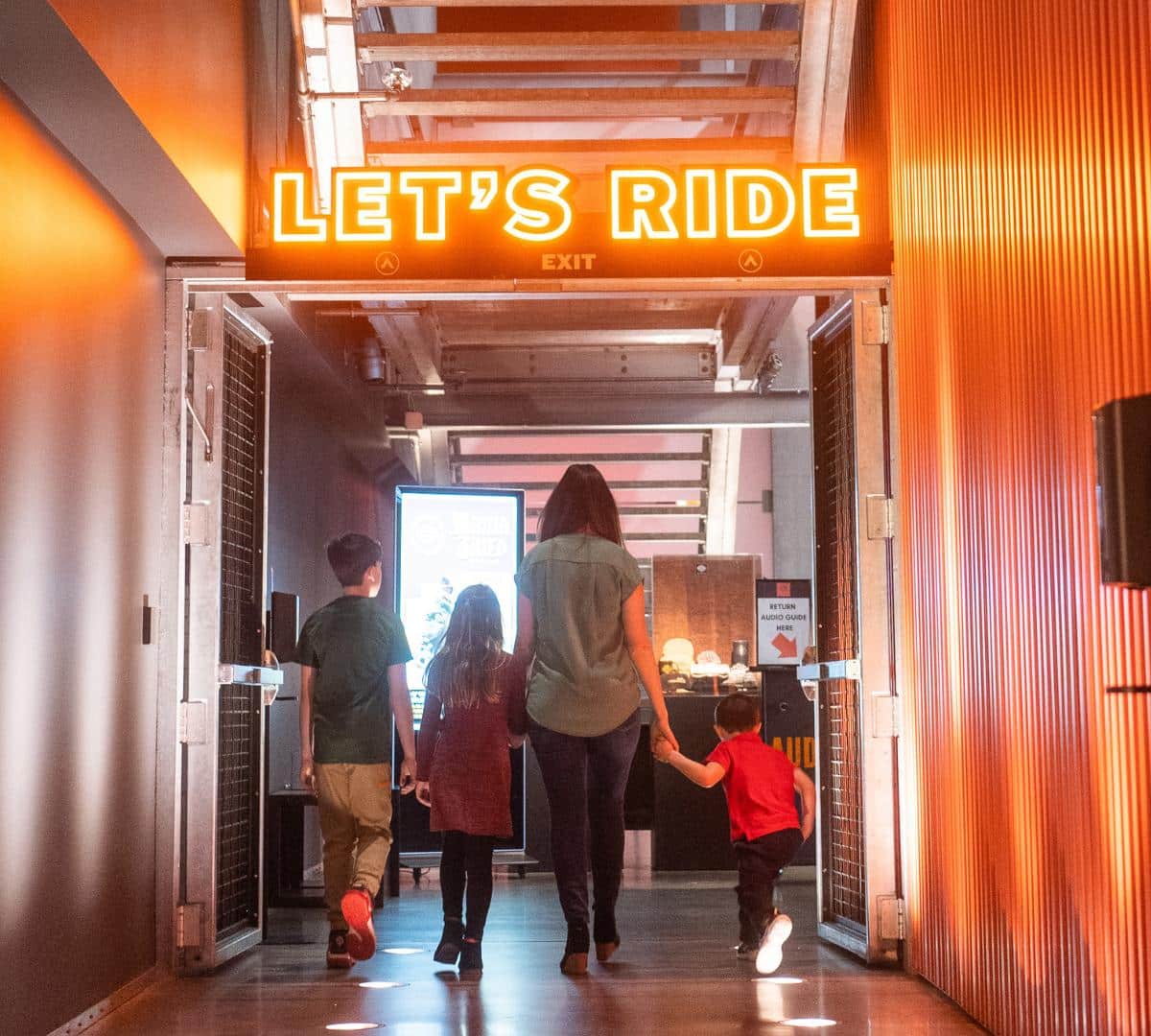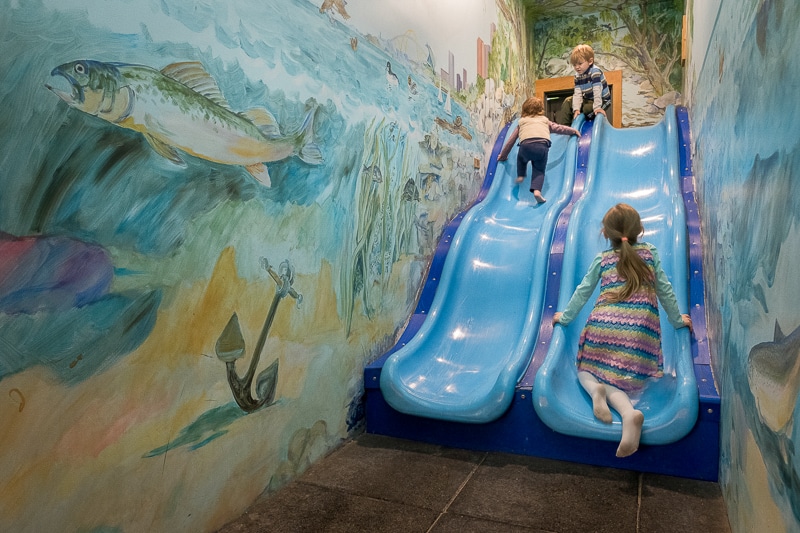Whether it’s the first day of school or the beginning of camp, those initial moments can be both exciting and nerve-wracking for kids.
As a summer camp counselor and public school teacher for more than 15 years, I’ve run my fair share of getting-to-know-you activities.

And I made it my mission to create a welcoming atmosphere where every child feels comfortable expressing themselves.
I’ve gathered a list of 50 fantastic “Getting To Know You” activities that have been tried, tested, and loved by children under my care.
These fun icebreaker games are not just mere activities; they are tools to unlock conversation, inspire teamwork, and most importantly, to have fun!
So whether you’re a teacher, a counselor, or a parent looking to break the ice, there’s something here for everyone.
1. Name Game
The classic Name Game is a fun icebreaker where kids sit or stand in a circle and introduce themselves by stating their name along with an animal that starts with the same letter. For example, “My name is Sam, and I like Snakes.”
As the game progresses, each child must remember and recite all the previous names and animals before adding their own. This activity not only helps children learn each other’s names but also sharpens their memory and listening skills. It’s great for groups of kids aged 5 and up and takes about 15–20 minutes to play.
Variation: Instead of animals, you can use foods, countries, or any other category that might interest the kids.
2. Two Truths and a Lie
In this engaging activity, each child gets a chance to say two true statements and one false statement about themselves. The catch is that the rest of the group has to figure out which statement is the lie.
It’s a wonderful way for kids to share interesting facts about their lives while practicing critical thinking and observation.
This game can be a hit with younger and older children, in classrooms, camps, or any group setting and takes approximately 15–20 minutes to complete, depending on the number of participants.
3. Human Bingo
This is an interactive version of traditional bingo designed to help kids get to know each other better. Create bingo cards filled with various traits or experiences like “Has a pet dog” or “Loves to read.” Children then walk around asking each other questions to see who can fill in a row or column first.
Not only is this game great for socializing, but it also helps kids learn how to ask questions and listen carefully to answers. It can be easily adapted for younger kids and older kids.
4. Snowball Fight
In this unique icebreaker, kids write down a fun fact about themselves on a piece of paper and then crumple it into a “snowball.” They then have a mock snowball fight, tossing the paper balls at each other.
After a few minutes, each child picks up a snowball, unfolds it, and reads the fact, taking a guess at who it belongs to. It’s a playful way to learn fun tidbits about each other while getting some energy out. Elementary students love it!
5. Would You Rather?
This classic game is always a crowd-pleaser and can be adapted for any age group. The facilitator or the kids themselves pose questions with two choices, and each child must choose one. For example, “Would you rather eat only ice cream for a week or never eat ice cream again?”
These are great icebreaker questions to spark conversations with a new student and learn more about individual preferences, and it usually results in a lot of laughs.
6. The Shoe Game
Everyone takes off one shoe and throws it into a pile in the center. After mixing up the shoes, each child picks one shoe and must find its owner. But there’s a catch; they must also learn one interesting fact about the person before returning the shoe.
This is a unique and fun way to encourage kids to get to know each other, and it’s always fascinating to see how they react to the diverse range of footwear!
7. Four Corners
Each corner of the room is labeled with a category option such as ‘Favorite Seasons: Summer, Fall, Winter, Spring.’ At the signal, kids run to the corner that aligns with their preference. Once there, they discuss among themselves why they chose that particular option.
It’s a quick way to get kids moving and also allows them to connect with new friends over shared preferences, making it a good icebreaker for both physical activity and conversation.
8. Never Have I Ever
In this circle game, one child stands in the center and announces something they’ve never done, like “I’ve never been to a beach.” Anyone who has done that activity must stand up and find a new seat, including the child in the center.
This leads to a flurry of activity and is an entertaining way for kids to learn unique or surprising facts about each other. Here are some Never Have I Ever Questions For Kids to get you started.
9. Magic Carpet Ride
In this teamwork challenge, kids stand on a small rug or mat, often referred to as the “magic carpet.” The objective is to flip the carpet over without anyone stepping off of it. This often leads to hilarious maneuvers and strategies as kids work together to solve the problem.
It’s an excellent exercise for problem-solving, communication, and collaboration skills.
10. The M&M Game
In this colorful icebreaker, each child picks an M&M candy from a bowl. Based on the color they pick, they’ll answer a corresponding question (e.g., red for “What’s your favorite sport?”, green for “Describe your dream vacation”).
It’s a sweet way to get kids talking and sharing, and it also provides a fun treat. You can prepare the questions in advance and even display them on a chart for everyone to see.
11. Zip Zap Zop
Group members stand in a circle and engage in a quick-paced verbal exchange using the words “Zip,” “Zap,” and “Zop.” One child starts by pointing to another child and saying “Zip.” The pointed-to child then points to another kid and says “Zap,” and so on.
The tempo increases, making it more challenging and adding a layer of excitement. Any hesitation or error results in that child being “out.” It’s a great exercise for quick thinking and attentiveness.
12. String Theory
In this intriguing activity, you’ll start with a ball of yarn or roll of toilet paper. Say something interesting about yourself and then hold onto the end of the string as you toss the ball to a child. That child then shares something about themselves, holds onto a section of the string, and tosses the ball to another child.
This process continues until everyone is holding part of the string, forming a literal web of connections. Afterwards, they can tie part of the string around their wrist to show their inclusion in their new classroom, cabin, or community.
13. ABC Line-Up
This activity focuses on non-verbal communication and teamwork. Children are tasked with lining up in alphabetical order by their first or last names without speaking to each other. They can use gestures, charades, or any other non-verbal cues to organize themselves correctly.
It’s a fun challenge for the entire class that requires focus and cooperation, ideal for classroom settings or team-building events. It’s a great icebreaker game for introverted kids because they don’t have to speak to communicate and accomplish the task.
14. Color Groups
Color Groups is another silent yet interactive icebreaker. Each child receives a colored sticker placed on their back without them seeing the color. They are then tasked with grouping themselves according to color without talking, using only gestures and miming.
It’s a fun way to emphasize the importance of non-verbal communication and teamwork, and it works great for children of various age groups.
15. Guess the Leader
In this fun game, one child leaves the room while the remaining kids select a ‘leader’ who initiates simple movements like clapping or jumping. It helps if they sit in a large circle. The child returns to the room and tries to identify the leader while the group subtly follows the leader’s actions.
This is a great activity for honing observation skills and understanding group dynamics. It adds an element of suspense and strategy to the mix.
16. Pass the Parcel
A small gift is wrapped in multiple layers of paper, and a question is inserted between each layer. As music plays, the parcel is passed among the children. When the music stops, the child holding the parcel unwraps one layer and answers the question before passing it along.
This game is a good way to keep the energy high and offers a fun way for kids to share personal stories or preferences.
17. Bean Bag Toss Q&A
For this activity, set up buckets or containers, each labeled with a different question. Children take turns tossing a bean bag into one of the buckets. Once the bean bag lands, they must answer the question on that particular bucket.
It’s a fun, interactive way to get children talking and sharing, while also adding a physical component to the activity.
18. What’s in a Name?
Much like the earlier “Name Game,” this activity also involves names but adds the element of a favorite thing. Each child goes around the circle sharing their first name along with something they like that starts with the same first letter of their name (e.g., “I’m Danny, and I like dogs”).
It helps with memorization and provides an additional personal touch to introductions. This is a simple icebreaker that works well for younger students.
19. Scavenger Hunt
Scavenger hunts are always a hit among kids. Divide the children into teams and provide them with a list of items to find either around the room or in an outdoor area. Each team must work together to locate all the items as quickly as possible.
Not only does this activity encourage teamwork, but it also allows kids to observe their surroundings carefully, combining both fun and learning.
20. Tug-of-War
Tug-of-War is a classic outdoor game that requires a good deal of teamwork and strategy. Children are divided into two teams, each trying to pull the rope into their territory. It’s not just about brute strength; effective communication and collective effort are key to winning.
This game helps children understand the value of working in unison and also offers a fun, physical outlet.
21. Relay Races
Relay races are a timeless way to get the whole class or cabin active and engaged. Whether you opt for traditional baton-passing races or spice things up with silly relays like “egg and spoon,” the essence of teamwork remains.
Children learn to support their teammates while focusing on their individual roles, offering a balanced mix of competition and collaboration.
22. Blindfolded Obstacle Course
In this activity, kids take turns being blindfolded and guided through an obstacle course by their teammates who can use only verbal instructions.
The game tests the trust between teammates and also sharpens their verbal communication skills. The blindfolded participant learns to listen carefully, while the guide learns to give clear, precise instructions.
23. Puzzle Pieces
Hand out individual jigsaw puzzle pieces to each child, and then task them with finding others who have the pieces that fit with theirs.
This activity is a great metaphor for community building. Each child realizes that to complete the puzzle (or any group task), they need to find their “fit” and work cohesively with others. Plus, it offers a tangible reward: a completed puzzle at the end!
24. Story Circles
Sit the kids in a circle and start a collective storytelling game. One child begins with an opening sentence, and each successive child adds on, going around the circle. This activity not only fuels creativity but also encourages active listening.
It teaches kids to build upon others’ ideas, creating a shared narrative that everyone contributes to and enjoys. You can also do this one word at a time.
25. Build a Story
In this creative activity, children are given a specific theme and are paired up to build a short story or skit around it. This encourages teamwork, creativity, and narrative skills as each pair must collaborate to produce a coherent and entertaining piece.
At the end, each pair can present their story or skit to the group, giving everyone a chance to appreciate the variety of ways a single theme can be interpreted.
26. DIY Name Plates
Each child receives a paper with their name written in large letters, and their task is to decorate it in a way that reflects their personality. Markers, stickers, and other craft supplies can be used to bring their names to life.
After decorating, children pair up and explain the choices they made while decorating their name. This offers a creative avenue for self-expression and a conversation starter for discussing individuality.
27. 20 Questions
One child thinks of an object, animal, or person, and the others take turns asking different questions to figure out what it is. They have to be yes or no questions! The game continues until someone correctly identifies the item or until 20 questions have been asked.
This simple but effective game hones deductive reasoning skills and teaches the art of asking insightful questions, all while keeping the group engaged.
28. Common Ground
In this fun activity, children form groups based on shared interests or traits—like owning a pet, enjoying a particular sport, or loving to read. Within their small groups, they discuss what they have in common, enabling them to quickly find a shared connection.
This is an easy way to promote inclusivity and highlight the things that bring people together rather than what sets them apart.
29. Reverse Musical Chairs
In this twist on the classic game of musical chairs, start with one fewer chair than the number of kids. The child left standing must ask a question to the group—anything from “Who likes pizza?” to “Who has been to the beach?” Anyone who can answer “yes” to the question has to get up and find a new seat.
The game continues until everyone has had a chance to ask a question. It’s a great way for kids to learn new things about their peers and find commonalities.
30. Me Too!
In this fun and fast-paced game, children sit in a circle while one stands in the middle and states something they like or a fact about themselves. Those who share the same sentiment shout, “Me too!” and scramble to find a new seat, including the one in the middle.
The last person left standing becomes the new one in the middle. It’s a great way to discover shared interests and keep energy levels high.
31. Odd One Out
Present the group with a list of four items, one of which is the “odd one out.” Children take turns identifying the odd item and explaining why it doesn’t belong.
This activity stimulates critical thinking and offers a great platform for kids to practice articulating their thoughts clearly. It’s also interesting to hear different perspectives on why an item is the “odd one out.”
32. Quick Draw
Give each child a piece of paper and a topic (like favorite food, family, or hobbies). They then have 30 seconds to draw something related to the topic. After time’s up, everyone shares their drawing with a partner and gives a brief explanation.
This activity promotes quick thinking and creativity and offers a glimpse into each child’s interests and talents.
33. Island Survival
Tell the children that they’re stranded on a deserted island and can bring only three items with them. Each child then shares with a partner what they would bring and explains their choices.
This thought-provoking activity promotes critical thinking and gives insights into each child’s priorities and problem-solving abilities.
34. Yes, and…
Children sit in a circle and create a collective story. The first kid starts with a sentence, and each subsequent participant has to add onto the story by starting their sentence with “Yes, and…”
This exercise encourages active listening, creativity, and collaborative storytelling, and it often results in hilariously unexpected narratives.
35. Superhero Identity
Each child draws a piece of paper from a hat, each containing the name of a superhero trait like super strength or invisibility. They then explain how they would use this newfound superpower for good.
This activity lets kids explore their imaginative sides and consider the responsibilities that come with power. This is a good icebreaker for young children.
36. Name Toss
Children stand in a circle. The first person says their name and tosses a beach ball to someone else in the circle. The next person must catch the ball, say the first person’s name, add their own, and toss it to another player.
This game continues until all names have been said and everyone has participated. Not only does this activity get kids moving, but it also helps them remember each other’s names in a fun and interactive manner.
37. Mirror, Mirror
In this activity, kids pair up and face each other. One child makes slow and deliberate movements while the other tries to mirror them as accurately as possible. Then, they switch roles. This game sharpens observation skills, heightens focus, and encourages nonverbal communication.
It’s a simple but powerful way to promote empathy and understanding between kids. Kids of all ages can participate in this activity pretty readily.
38. Animal Sounds
In this lively game, each child draws the name of an animal from a hat. Without revealing their animal, they must make its sound, and the others must guess which animal it is. This game is not only entertaining but also educational, as children get to learn about different animals and the sounds they make.
It can be particularly enjoyable for younger children and serves as a great way to inject some fun and learning into any gathering.
39. Funny Faces
Children sit in a circle, and one starts by making a funny face. The person to their immediate right must try to copy the funny face as accurately as possible. This continues around the circle until it reaches the last person, who must try to replicate the first person’s funny face.
This activity is not only hilarious but also encourages attention to detail and offers a break from more structured activities.
40. Hula Hoop Pass
In this activity, children stand in a circle holding hands and must find a way to pass a hula hoop around the circle without letting go of each other’s hands. They’ll have to twist, turn, and work together to achieve this feat, making it a great exercise for teamwork and creative problem-solving.
It’s a challenging yet fun way for kids to engage with each other, promoting both cooperation and physical activity.
41. Map It Out
Provide each child with a world map and a set of stickers. Ask them to place a sticker on a location they’d like to visit someday, and then share why they chose that particular place.
This activity not only sparks interesting discussions but also offers a valuable geography lesson. It allows kids to learn about different cultures and dreams, broadening their worldviews.
42. The Telephone Game
This classic game starts with one child whispering a phrase to the person sitting next to them. That child then whispers the phrase to the next person, and so on, until the message reaches the last child, who says it out loud.
At the end of the game, the original phrase is revealed, often leading to laughter at how much the message has changed. This game underscores the importance of clear communication while adding an element of surprise and humor.
43. Trading Places
Children sit in a circle on chairs with one child standing in the middle. The child in the middle says a statement like, “Trade places if you are wearing red.” Anyone who meets the criteria must stand up and find a new seat, while the child in the middle tries to take one of the vacated seats.
The game is a fun way to get kids moving and allows them to quickly find commonalities among them, like favorite colors or types of clothing.
44. Building Blocks of Me
Give each child a set of building blocks and challenge them to build a structure that represents something about their life or personality. After everyone has finished building, each child presents their structure and explains its significance.
Whether they build a complex castle to represent their layered personality or a straightforward tower to symbolize their love of heights, this activity provides a tactile and visual way for kids to share more about who they are.
45. Flag Making
In this creative activity, each child designs a flag that represents their very own “country”—an imaginative place where all their favorite things exist. They can include symbols, colors, or drawings that are significant to them.
Once everyone is done, the children present their flags and explain the elements they’ve included. This activity allows kids to be creative while also providing a window into their interests and personalities. Afterwards, they can share and discuss with a new friend.
46. Hot Potato
A small object serves as the “hot potato” that kids pass around the circle while music plays. When the music stops, the child holding the hot potato has to answer a fun question, which could be about their favorite food, a place they’d like to visit, or a talent they have.
This game is simple, entertaining, and helps the kids learn random but interesting facts about one another.
47. Freeze Dance
Freeze Dance is always a hit with children, but in this version, when the music stops, each child must freeze and quickly find a partner. The pairs then have a brief moment to share something about themselves with each other.
This adds a new layer of interaction to a classic game and serves as an ice-breaker that gets kids both moving and talking.
48. Build a Tower
Kids are divided into groups and given a limited amount of paper and tape. Their challenge is to collaborate and construct the tallest tower they can within a set timeframe.
This activity promotes teamwork, creativity, and problem-solving in a fun, competitive environment. This activity is especially great for middle school students.
49. Word Association
In this verbal game, a child says a word out loud, and the next child has to say the first word that comes to their mind that’s associated with the previous word. This continues around the circle. It’s a fun way to get kids thinking quickly and creatively while learning how their peers think as well.
In this introspective activity, children are encouraged to think about a place that brings them joy and peace—be it a real location, a fantasy world, or even a state of mind. They can either describe this “happy place” verbally or draw it on paper.
Once everyone has had a turn, the kids can share their happy places, giving insight into what makes each of them feel secure and joyful.
51. What’s Your Superpower?
Each child takes a moment to think about what they consider to be their unique talent or “superpower.” It could be something like being a good listener, excelling in a particular subject, or even something fun like being able to wiggle their ears! There is no correct answer.
The kids then discuss their superpowers with the group. This activity helps boost self-esteem and allows children to appreciate their own and others’ unique abilities.
52. Rose, Bud, and Thorn
In this reflective activity, each child shares one “rose” “bud” and one “thorn” from their week. The “rose” is a highlight or something positive that happened, while the “thorn” is a challenge or something they found difficult. The “bud” is what they’re exciting about for tomorrow or next week.
This is an excellent way for kids to practice gratitude for the good moments and also share and find support for their challenges.
53. Kind Words
Each child writes down a positive statement or compliment about another person in the room on a piece of paper. These papers are then collected and redistributed randomly or read out anonymously by the facilitator. This activity serves to foster a culture of kindness and appreciation among the kids.
54. Screen Sharing Art
In this virtual activity, children can share digital art or pictures that align with their interests or hobbies. Using the screen sharing feature, each child has the opportunity to showcase images that are meaningful to them, whether it’s digital art they’ve created themselves or an image that resonates with them.
It’s a creative way to enable self-expression and celebrate the diversity of interests within the group.
55. Virtual Home Tour
With parental permission, children can give a brief virtual tour of a part of their home, sharing a space that is special or important to them. Whether it’s their bedroom, a cozy reading nook, or even the backyard, this activity provides a unique and personal way for kids to share a bit about their lives.
It offers an intimate look into each child’s personal environment and can serve to deepen friendships and understanding among the group.
The start of the school year can be stressful!
As a seasoned camp counselor and public school teacher with over two decades of experience, I’ve seen firsthand how meaningful and fun icebreakers can be in fostering a sense of community and rapport among children.
When children are engaged in fun icebreaker activities that encourage them to open up and be themselves, the result is a group that is not only more cohesive but also more capable of empathy, collaboration, and mutual respect.
Happy bonding!
Related Posts:
250 Best Morning Meeting Questions For Kids
100 Best Hypothetical Questions For Kids
250 Hilarious Never Have I Ever Questions For Kids
100+ Science Trivia Questions for Kids
250 Best Jeopardy Questions For Kids
Plus: Looking for fun ways to engage students later in the year? Check out our Twosday Activities for exciting, interactive ideas to celebrate the special date with your class!
Calie Herbst, Editor-in-Chief of Milwaukee With Kids, has spent over a decade combining her experiences as a parent of three to create a hub for Milwaukee’s family adventures.
Her decade-long teaching career in Milwaukee Public Schools and academic background, including a Master’s in Teaching from Marquette University and dual B.A.s in Sociology and Spanish from the University of Wisconsin – Madison, fuel her passion for inclusive and engaging family content.
Calie is also a recognized voice in local media, contributing to WISN Channel 12 News, WTMJ Wisconsin Morning News, Fox 6’s Real Milwaukee, and B93.3.
Discover more about Calie’s journey and editorial approach on her About Page and Editorial Policy Page.









